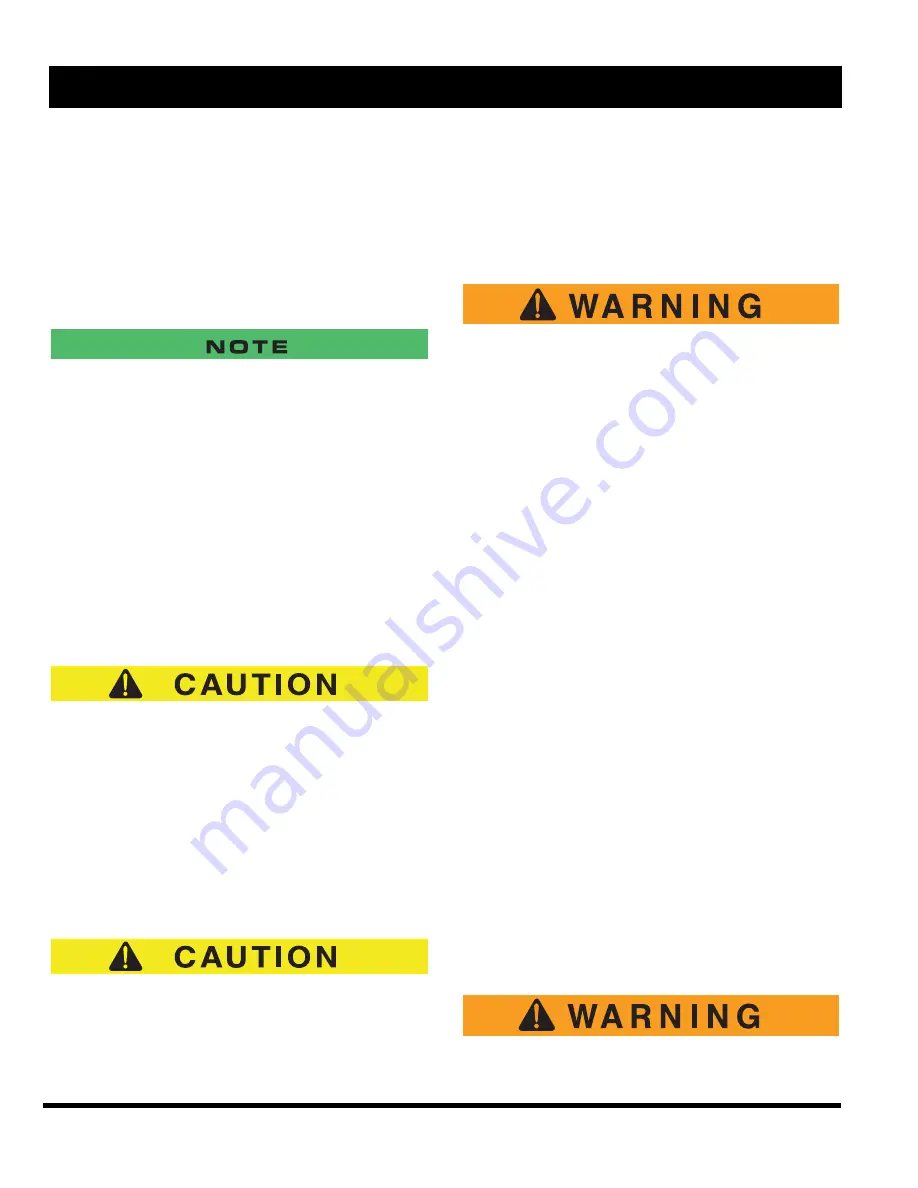
OPERATION AND SERVICE INFORMATION
Page 12
Owner’s Manual and Service Guide
Read all of Manual to become thoroughly familiar with this vehicle. Pay particular attention to all Notes, Cautions and Warnings
Depressing the accelerator pedal energizes the starter
and ignition circuits which cause the engine to run. To
start the vehicle: Apply the service brake, place the key
in the key switch and turn it to the ‘ON’ position. Move the
direction selector to the direction desired. Release the
parking brake by pressing the release button in the end
of the handle while slightly raising the handle. Then lower
the parking brake handle. Slowly depress the accelerator
pedal to start the engine while releasing service brake.
When the direction selector is in the ‘R’ (reverse) position, a
warning signal will sound. This is a device to indicate that the
vehicle is ready to run in reverse.
When the accelerator pedal is released, the ignition cir-
cuit is de-energized and the engine stops. To stop the
vehicle more quickly, depress the service brake pedal.
When leaving vehicle unattended, turn key to ‘OFF’ posi-
tion and remove, engage parking brake and place direc-
tion selector in ‘FORWARD’ position.
Cold Starting
Starting a cold engine may require use of the choke.
Depress the accelerator approximately 1" (2.5 cm) or
until the starter just begins to operate.
Do not allow the starter to operate continuously for more
than 30 seconds. Allow 10 seconds before attempting a
second time. If the vehicle does not start on the third
attempt, turn the key switch off, engage the parking
brake and determine the cause of the problem.
Pull the choke knob out and hold knob in position until
engine starts and runs smoothly. Then push knob in. The
choke knob must be pushed in fully once engine has
reached operating temperature.
Starting the Vehicle on a Hill
Do not hold vehicle on hill by using the accelerator and
engine. This will cause premature and excessive wear to
drive train components.
When starting the vehicle on a hill, it is important to follow
the procedure below to prevent excessive roll back and
possible permanent damage to the drive train system.
Place left foot on service brake and release parking
brake. Place right foot on accelerator. As accelerator is
depressed with the right foot, release the service brake.
Starting the Vehicle with a Discharged
Battery
Do not attempt to ‘jump start’ a vehicle using
another vehicle.
The vehicle is equipped with a starter/generator. When
starting the engine, the starter/generator functions as a
starter and with the engine running, it functions as a gen-
erator. Since the engine stops when the accelerator is
released,
do not attempt jump starting.
With the running times associated with this kind of vehi-
cle, the generator is more than adequate to maintain the
battery charge level. The generator is not designed to
charge a discharged battery.
If the vehicle is equipped with additional lights and/or a
strobe light that is used when the vehicle is not in motion,
the starter/generator may not be adequate to maintain
battery charge. If the vehicle battery has become dis-
charged, it must be charged using a 12V charger that is
rated at 10 amps or less. Observe all instructions pro-
vided by the manufacturer of the charger.
COASTING
On steep hills, it is possible for the vehicle to coast while
in gear at greater than normal speeds encountered on a
flat surface. To prevent loss of vehicle control, speeds
should be limited to no more than the maximum gov-
erned speed on level ground (see GENERAL SPECIFI-
CATIONS). Limit speed by applying the service brake.
Severe damage to the drive train components may result
due to excessive speed. Damage caused by excessive
speed may cause a loss of control, is costly to repair, is
considered abuse and will not be covered under war-
ranty.
FUEL
To prevent a possible explosion, do not smoke
near the fuel tank or refuel near open flame or
electrical items which could produce a spark.
Summary of Contents for ST 480 2007
Page 8: ...Page vi Owner s Manual and Service Guide TABLE OF CONTENTS Notes...
Page 12: ...Owner s Manual and Service Guide Notes Page x SAFETY INFORMATION...
Page 47: ...Page 29 Owner s Manual and Service Guide GENERAL SPECIFICATIONS GENERAL SPECIFICATIONS...
Page 51: ...Appendix A 1 Owner s Manual and Service Guide LABELS AND PICTOGRAMS LABELS AND PICTOGRAMS...
Page 57: ...Appendix B 1 VEHICLE WARRANTIES Owner s Manual and Service Guide VEHICLE WARRANTIES...
Page 64: ...Appendix C 2 Owner s Manual and Service Guide DECLARATION OF CONFORMITY...
Page 65: ...Appendix C 3 DECLARATION OF CONFORMITY Owner s Manual and Service Guide...
Page 66: ...Appendix C 4 Owner s Manual and Service Guide DECLARATION OF CONFORMITY NOTES...
Page 74: ...Sidan vi garhandbok och underh llsguide INNEH LLSF RTECKNING Anm rkningar...
Page 78: ...garhandbok och underh llsguide Sidan x S KERHETSINFORMATION Anm rkningar...
Page 113: ...Sidan 29 garhandbok och underh llsguide ALLM NNA SPECIFIKATIONER ALLM NNA SPECIFIKATIONER...
Page 117: ...Bilaga A 1 garhandbok och underh llsguide ETIKETTER OCH SYMBOLER ETIKETTER OCH SYMBOLER...
Page 123: ...Bilaga B 1 FORDONETS GARANTIER garhandbok och underh llsguide FORDONETS GARANTIER...
Page 130: ...Bilaga C 2 garhandbok och underh llsguide RS KRAN OM VERENSST MMELSE...
Page 131: ...Bilaga C 3 RS KRAN OM VERENSST MMELSE garhandbok och underh llsguide...
Page 132: ...Bilaga C 4 garhandbok och underh llsguide RS KRAN OM VERENSST MMELSE ANTECKNINGAR...
















































